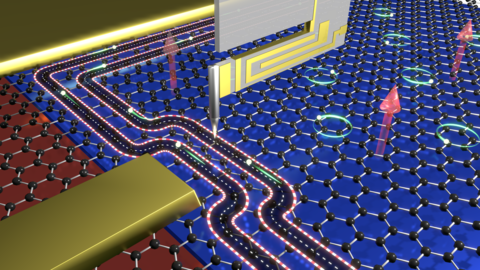NIST team probes indestructible quantum states that may aid quantum computing
Living on the edge has its benefits.

Schematic of quantum Hall edge states in graphene probed by an atomic force microscope. In the interior of the graphene sheet, electrons under the influence of a perpendicular applied magnetic field are constrained to undergo circular motion. This turns the interior of the graphene sheet into a poor electrical conductor and even into an insulator under certain conditions. In contrast, along the boundary of the graphene, so-called topologically protected edge states provide runways for charge carriers to flow easily, creating conducting edge channels.
They may not be impervious to bullets like Superman, but groups of electrons that gather along the edges of some ultrathin materials have their own superpowers. Defying such disturbances as bending, stretching, the introduction of an external magnetic field, and distortions that wreck the orderly arrangement of atoms in a crystal, these groups of electrons, known as quantum Hall (QH) edge states, still maintain their properties and positions.
The persistence of QH edge states makes for some weird and wonderful physics. For instance, the states help explain why the interior of atomically thin layers of some materials act as insulators, preventing the flow of electric current, while their edges are excellent conductors — enabling current to flow freely along the perimeter. The discovery of these materials, known as topological insulators, and the explanation for how they work, have garnered two Nobel Prizes in Physics.
In addition, physicists are exploring whether the durability of the QH edge states may qualify them as good candidates for quantum bits, or qubits, the fundamental unit of quantum information. Although qubits can carry much more information than classical computer bits, their quantum properties can easily be disturbed, destroying the data they have stored. QH edge states may offer a more robust alternative.
For all their intriguing properties, the QH edge states have eluded imaging, even though they contribute to the resistance — a macroscopic property — of the material in which they reside. Now researchers at the National Institute of Standards and Technology (NIST) in Gaithersburg, Md., and their international team of collaborators have taken images of these edge states and examined their underlying structure and size.
The researchers, who include Sungmin Kim, Daniel Walkup, Johannes Schwenk, Joseph Stroscio and Nikolai Zhitenev, describe their work in the May 14 issue of Nature Communications.
The team examined the QH edge states in graphene — a one-atom-thick sheet of carbon atoms arranged in a honeycomb structure. Graphene is of particular interest because it provides a possible new and robust standard for electrical resistance. When chilled to a few degrees above absolute zero and subjected to a strong magnetic field, graphene exhibits the QH effect, in which resistance across the layer can only take on perfectly exact, discrete values, like rungs on a ladder, determined by the constants of nature. (The resistance can be measured to an accuracy better than one part in a billion.)
Using an atomic force microscope (AFM) whose sharp tip is sensitive to tiny changes in electrical forces, the NIST team imaged the energy levels within individual QH states. They also found that the QH edge states have a diameter of about 10 nanometers (billionths of a meter), a width equivalent to about thirty atoms.
To better understand the properties of the QH effect in their graphene sample, the researchers used a trio of instruments that simultaneously measured microscopic and macroscopic properties of the material. For the microscopic measurements, the team combined an AFM and a scanning tunneling microscope, which examines the atomic-scale topography and electronic structure of the QH states. In tandem with these tools, the team recorded the flow of current at different magnetic field strengths (a macroscopic quantity).
This three-in-one tool kit, which the team likens to a Swiss army knife, is critical for studying so-called quantum materials such as graphene. For many ordinary materials, quantum effects can often be ignored on large scales. But in quantum materials, strong quantum effects between groups of electrons persist over large distances. These effects lead to remarkable properties, such as the QH edge states, that can be harnessed for new technologies but must be examined with a suite of instruments.
The team is still analyzing how the energy levels and positions of the QH edge states compare with theoretical predictions. They next plan to examine edge states that emerge when two sheets of graphene are sandwiched together, with each sheet twisted or rotated by a different angle. The rotated layers may create novel edge states with properties not previously known, opening a new avenue of research and suggesting additional applications for quantum communication, Stroscio said.
Paper: S. Kim, J. Schwenk, D. Walkup, Y. Zeng, F. Ghahari, S.T. Le, M.R. Slot, J Berwanger, S.R. Blankenship, K. Watanabe, T. Taniguch, F.J. Giessibl, N.B. Zhitenev, C.R. Dean, and J.A. Stroscio. Edge Channels of Broken-Symmetry Quantum Hall States in Graphene visualized by Atomic Force Microscopy. Nature Communications, 2021. DOI: 10.1038/s41467-021-22886-7

